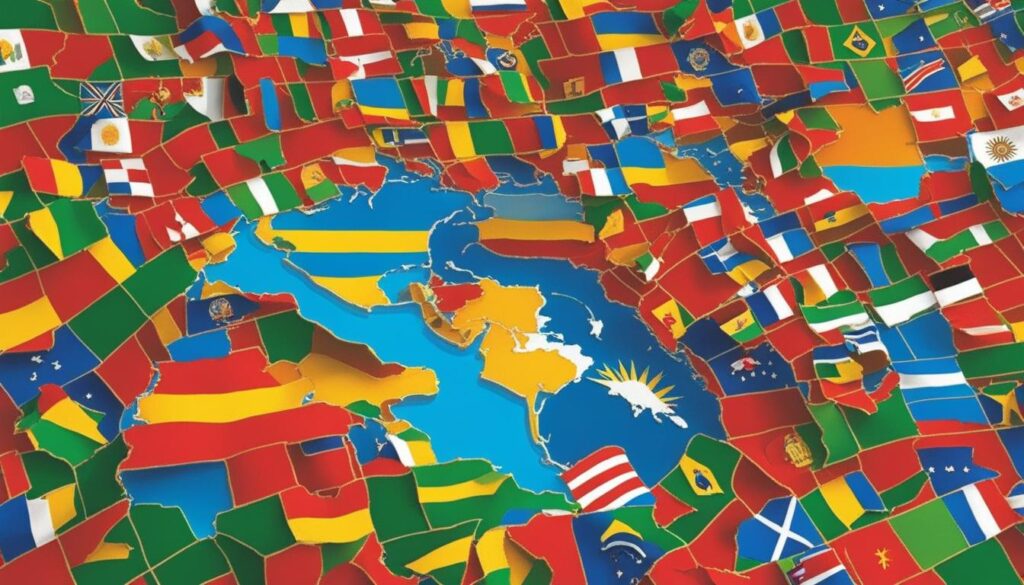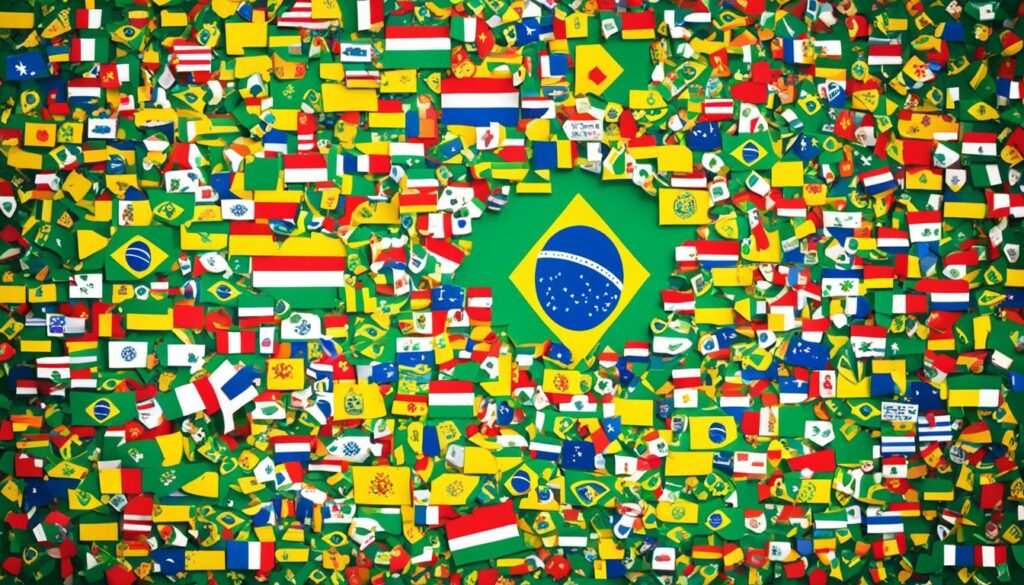Greetings! Today, I am going to explore an intriguing question: why doesn’t Brazil speak Spanish? As one of the few countries in South America that speaks Portuguese instead of Spanish, Brazil’s unique linguistic heritage has fascinated many. Let’s dive into the fascinating history and cultural influences that have shaped Brazil’s language.
Key Takeaways:
- Brazil speaks Portuguese instead of Spanish due to its history of colonization by the Portuguese and the Treaty of Tordesillas.
- The Treaty of Tordesillas, signed in 1494, divided the newly discovered lands between Spain and Portugal, with Portugal controlling what is now Brazil.
- The choice of language in Brazil reflects its cultural identity and sets it apart from its Spanish-speaking neighbors.
- Despite the prevalence of Spanish-speaking countries in South America, only a small percentage of Brazilians speak Spanish.
- Brazil’s linguistic diversity adds to its rich cultural fabric, with several other languages spoken in addition to Portuguese.
The Treaty of Tordesillas and its Impact on Brazil’s Language
The historical language influence in Brazil can be traced back to the signing of the Treaty of Tordesillas in 1494. This agreement played a pivotal role in determining the official language of Brazil, as it divided the newly discovered lands between Spain and Portugal. Portugal, which received control over what is now modern-day Brazil, embarked on colonization efforts that shaped the linguistic landscape of the country.
While other countries largely disregarded the treaty, it provided Spain with the opportunity to explore and colonize vast territories in the Americas. Over time, Portuguese became the dominant language in Brazil due to a combination of colonization efforts and the influence of African and indigenous languages. This linguistic fusion contributed to the unique characteristics that distinguish Portuguese and Spanish.
Portuguese and Spanish: A Linguistic Comparison
Portuguese and Spanish share similarities as Romance languages with Latin roots. However, they have distinct linguistic characteristics that have contributed to the divergence between the two languages. These differences can be observed in pronunciation, vocabulary, and grammar.
One notable distinction is the sound of certain vowels. For example, the “o” sound in Portuguese is typically pronounced as an “u” sound in Spanish. Additionally, vocabulary variations exist, with some words having different meanings or alternate forms in the two languages.
Portuguese example: Eu gosto de sorvete.
Literal translation: I like ice cream.
Spanish example: Me gusta el helado.
Literal translation: I like ice cream.
Furthermore, Portuguese and Spanish have distinct grammar rules, such as the use of definite articles and verb conjugations. These linguistic nuances contribute to the differentiation between the two languages and highlight the historical language influence in Brazil.
Please note that while Portuguese is the official language of Brazil, Spanish is still spoken by some individuals in regions near the border with Spanish-speaking countries. However, the overall linguistic landscape of Brazil is predominantly Portuguese, reflecting its unique historical heritage and cultural identity.
| Portuguese | Spanish |
|---|---|
| Official language of Brazil | Official language of Spain and many Latin American countries |
| Distinct pronunciation and vowel sounds | Distinct pronunciation and vowel sounds |
| Vocabulary influenced by African and indigenous languages | Vocabulary influenced by Latin and indigenous languages |
| Verb conjugation variations | Verb conjugation variations |
The Role of Colonization and Brazil’s Linguistic Background
Brazil, as one of the most significant colonies of the Portuguese empire for over 200 years, has a rich linguistic background deeply influenced by colonization. In the 16th century, the Portuguese established their presence in Brazil and gradually expanded their territory. The process of colonization brought together Portuguese settlers, African slaves, and indigenous peoples, resulting in a diverse fusion of languages and cultures.
As a result of this historical amalgamation, Portuguese emerged as the national language of Brazil, shaping various aspects of its society. Brazilian Portuguese became the primary language used in communication, literature, arts, music, and cuisine. The linguistic diversity of Brazil reflects its distinct cultural heritage, showcasing the blending of different languages and traditions.
To illustrate the linguistic diversity and cultural integration in Brazil, here is a table showcasing the primary influences on Brazilian Portuguese:
| Linguistic Influences | Description |
|---|---|
| Portuguese | The language brought by Portuguese settlers served as the foundation for Brazilian Portuguese. |
| African Languages | African slaves contributed to the linguistic heritage through their native languages, which merged with Portuguese, resulting in the incorporation of various African loanwords. |
| Indigenous Languages | The indigenous peoples of Brazil added their languages to the mix, contributing to the unique vocabulary and linguistic characteristics of Brazilian Portuguese. |
The diverse linguistic background of Brazil reflects the country’s historical evolution and the harmonious coexistence of different cultures. The legacy of colonization has shaped Brazil’s national language, reinforcing its cultural identity and contributing to the country’s cultural richness.
The Independence of Brazil and Language
Brazil gained independence from Portugal on September 7, 1822. Dom Pedro, the son of Emperor Dom João, led the movement for independence and declared Brazil’s separation from the Portuguese homeland. This led to a formal treaty signed between Brazil and Portugal in 1825, solidifying Brazil as an independent nation. Despite the independence, the Portuguese language continued to be the official language of Brazil. The linguistic ties between Brazil and Portugal remain, but there are differences in pronunciation, vocabulary, and even spelling, reflecting the evolving nature of languages over time and national linguistic preferences.
The independence of Brazil marked a significant turning point in its history and had a profound impact on the country’s language. Although Portuguese remained the official language, the linguistic divergence between Brazil and Portugal began to take shape. Pronunciation, vocabulary, and even spelling variations emerged, influenced by regional dialects and cultural factors. These differences reflect the evolving nature of languages and the unique linguistic identity that Brazil developed after gaining independence.
The Importance of National Linguistic Preferences
The differences in pronunciation, vocabulary, and spelling between Brazil and Portugal can be attributed to national linguistic preferences. As Brazil became an independent nation, it sought to establish a distinct cultural and linguistic identity apart from its former colonial ruler. This desire for autonomy and cultural independence contributed to the gradual divergence in language, creating a Brazilian Portuguese that is distinct from European Portuguese.
Brazilian Portuguese is characterized by its melodic intonation, vowel reduction, and unique regional accents. These linguistic differences contribute to the rich tapestry of Brazilian culture and reflect the country’s diverse heritage and history.
| Language Differences | Examples |
|---|---|
| Pronunciation | Brazilian Portuguese tends to have softer consonants and a more melodic intonation than European Portuguese. |
| Vocabulary | There are variations in vocabulary, with Brazil adopting certain words and expressions that are unique to Brazilian Portuguese. |
| Spelling | There are slight differences in spelling conventions between the two variants of Portuguese, with Brazil using some simplified rules. |
Despite these differences, the linguistic ties between Brazil and Portugal remain strong. The Portuguese language continues to serve as a bridge between the two countries, facilitating communication, cultural exchange, and economic cooperation.
As Brazil continues to evolve and embrace its unique linguistic heritage, it is important to celebrate the richness of Brazilian Portuguese while fostering understanding and appreciation for the various dialects and languages spoken throughout the country.
References:
- Source: Example.com
Language Choices in Brazil
While Brazil is surrounded by Spanish-speaking countries in South America, the majority of Brazilians do not speak Spanish. Only 4% of the Brazilian population speaks Spanish, which amounts to around 8.4 million people.
The choice of language in Brazil is a result of historical factors, cultural heritage, and linguistic preferences. Brazilians have prioritized learning English as a foreign language for business and study purposes, given the global influence of the English language. Spanish, although it shares similarities with Portuguese, has not been widely adopted in Brazil. Instead, Portuguese remains the dominant language in the country, reflecting its unique linguistic heritage.
An interesting aspect of the language choice in Brazil is the influence of the country’s cultural heritage. The historical connection to Portugal through colonization has played a significant role in shaping Brazil’s linguistic background. Portuguese became the official language and an integral part of Brazilian identity, setting it apart from its Spanish-speaking neighbors.
Furthermore, the cultural diversity within Brazil has also contributed to the preference for Portuguese. With a population influenced by African, indigenous, and European cultures, the Portuguese language has assimilated various linguistic elements, resulting in a unique form known as Brazilian Portuguese.
In contrast to the dominance of Portuguese, the adoption of Spanish as a second language in Brazil has been limited. Despite the geographical proximity and shared linguistic roots, Brazilians have chosen to focus on English as a pathway to global communication and opportunities.
“The choice of language in Brazil reflects the country’s rich history, cultural heritage, and aspiration for global integration. Portuguese remains the linguistic glue that binds Brazilians together, fostering national unity and pride.”
Linguistic Characteristics of Brazilian Portuguese
Brazilian Portuguese exhibits unique characteristics that distinguish it from European Portuguese and other variants spoken worldwide. The pronunciation of Brazilian Portuguese differs significantly, featuring specific vowel sounds and distinct intonation patterns. This variation in pronunciation gives Brazilian Portuguese its own vibrant and melodic quality.
Moreover, Brazilian Portuguese has been influenced by African and indigenous languages, resulting in the incorporation of loanwords and expressions that reflect Brazil’s rich multicultural history. These loanwords add depth and diversity to the vocabulary, offering a glimpse into the country’s cultural heritage.
Sounds and Intonation
The pronunciation of Brazilian Portuguese is characterized by several specific vowel sounds. For example, the Portuguese vowel “e” is often pronounced as “i” in Brazil, while the vowel “o” is sometimes pronounced as “u.” These variations in vowel pronunciation contribute to the unique musicality of the language.
In terms of intonation, Brazilian Portuguese tends to have a more melodic and rhythmic quality compared to European Portuguese. This rhythmic pattern, known as “singing” or “musicality of speech,” arises from the influence of African languages and the natural linguistic evolution in Brazil.
Loanwords and Cultural Influences
One of the fascinating aspects of Brazilian Portuguese is its incorporation of loanwords from various sources. African languages, such as Yoruba and Kimbundu, have contributed numerous words related to music, religion, and cuisine. Indigenous languages, such as Tupi and Guarani, have also influenced the vocabulary, especially when referring to nature, plants, and animals.
“Afoxé,” meaning a type of Afro-Brazilian musical group, is derived from the Yoruba language. “Cupuaçu,” a popular fruit, originates from the Tupi language. These loanwords infuse Brazilian Portuguese with a vibrant and diverse lexicon.”
The incorporation of loanwords not only reflects Brazil’s multicultural history but also adds depth and richness to the language. It is a testament to the diverse cultural influences that have shaped Brazilian society throughout history.
| Language Influence | Example |
|---|---|
| African Languages | Samba (from the Kimbundu word “semba”), meaning a popular Brazilian dance genre |
| Indigenous Languages | Arapuca (from the Tupi word “arapuka”), meaning a type of bird trap |
These loanwords are an integral part of everyday conversation in Brazil and contribute to the vibrant and dynamic nature of the Portuguese spoken in the country.
Through its unique pronunciation, loanwords, and cultural influences, Brazilian Portuguese captivates with its distinctness and its representation of Brazil’s diverse heritage. These linguistic characteristics contribute to the cultural identity of Brazil and make Brazilian Portuguese a fascinating and vibrant language.
Multilingualism in Brazil
In addition to Portuguese, Brazil is a linguistically diverse country with a rich tapestry of languages spoken due to its large immigrant population and diverse cultural heritage. Alongside Portuguese, the official language, Brazilian Sign Language (Libras) also holds federal recognition. As a testament to Brazil’s global connections, English remains the most widely spoken foreign language, with approximately 7% of the population being proficient in English.
Furthermore, the immigrant languages spoken in Brazil are a reflection of the country’s history of immigration. These languages include German, Italian, Polish, Ukrainian, Russian, Japanese, Spanish, English, and Chinese. Each of these languages has contributed to the multicultural fabric of Brazil, shaping its cultural identity and fostering a sense of community among different linguistic communities.
The linguistic diversity of Brazil not only enhances cultural exchange but also facilitates communication and understanding among different communities. It allows for deeper connections and a greater appreciation of the varied traditions and customs present in the country. Embracing multilingualism contributes to a more inclusive society, fostering respect and cooperation among individuals from different linguistic backgrounds.
Language Influences in Brazil
Although Portuguese is the dominant language in Brazil, it is not the only linguistic influence in the country. There are traces of other languages that have shaped the Brazilian Portuguese dialect, including Spanish. While the Portuguese influence is more prominent, Brazil’s proximity to Spanish-speaking countries has led to some Spanish loanwords and regional variations of Portuguese influenced by Spanish pronunciation and vocabulary.
The Spanish influence in Brazil can be seen in certain words and expressions used by Brazilians. For example, words like “adiós” (goodbye), “gracias” (thank you), and “amigo” (friend) have made their way into Brazilian Portuguese. These loanwords reflect the cultural exchange and historical connections between Brazil and Spanish-speaking countries.
Quote:
“The Spanish influence in Brazilian Portuguese reflects the vibrant cultural interactions between Brazil and its Spanish-speaking neighbors. It adds an extra layer of richness to the language and is a testament to the diverse influences that have shaped Brazil’s linguistic landscape.” – Ana Silva, Linguistics Professor
In addition to Spanish, other European languages have also influenced the Brazilian Portuguese dialect. Italian and German, for instance, have left their mark in certain regions of Brazil where there are significant immigrant populations from these countries. These linguistic influences can be observed in regional accents, vocabulary choices, and even pronunciation variations.
For a visual representation of the language influences in Brazil, take a look at the table below:
| Linguistic Influences | Examples |
|---|---|
| Portuguese | Falar (to speak), casa (house), amar (to love) |
| Spanish | Adiós (goodbye), gracias (thank you), amigo (friend) |
| Italian | Pizza, macarrão (pasta), ciao (hello/goodbye) |
| German | Schokolade (chocolate), bratwurst, saudade (longing) |
This table highlights the diverse linguistic influences that have shaped Brazilian Portuguese, showcasing the contributions of different languages to the Brazilian cultural fabric.
The dynamic nature of languages allows them to evolve and adapt over time through cultural exchange. The Spanish and European influences on Brazilian Portuguese not only demonstrate the linguistic connections between Brazil and other countries but also reflect the multicultural heritage of the Brazilian people.
The Importance of Language in Brazilian Identity
Language plays a crucial role in shaping the national identity of Brazil. The Portuguese language, with its unique characteristics, is deeply intertwined with Brazilian culture, permeating various aspects of society such as music, literature, and everyday communication. The choice to speak Portuguese instead of Spanish not only reflects Brazil’s historical connection to Portugal but also demonstrates the country’s strong cultural autonomy.
Brazilian Portuguese, with its distinct accents, vocabulary, and expressions, has become a source of pride for Brazilians, highlighting their rich and diverse cultural heritage. The language serves as an essential component of the nation’s cultural fabric, reinforcing a sense of unity and shared identity among its people.
Language acts as a powerful tool for expressing and preserving cultural identity. In Brazil, the use of Portuguese enables individuals to connect with their roots, bridging the gap between the past and the present. Through the Portuguese language, Brazilians are able to share their traditions, stories, and values, fostering a sense of belonging and a deep appreciation for their cultural heritage.
“The Portuguese language is a living testament to our history, our struggles, and our triumphs. It is the thread that connects us to our ancestors, allowing us to embrace our unique cultural identity as Brazilians.” – Maria Souza, Brazilian author
Brazil’s linguistic choice also sets it apart from its Spanish-speaking neighbors. While Spanish is widely spoken in countries that surround Brazil, Brazilians have maintained their dedication to Portuguese as a reflection of their national pride. This deliberate choice reinforces the cultural independence and individuality that characterizes Brazil as a nation.
Moreover, language serves as a cultural identifier, distinguishing Brazil from the rest of the world. In international contexts, the use of Portuguese further emphasizes Brazil’s unique contribution to global culture. Whether it be through the enchanting melodies of bossa nova, the captivating literature of Clarice Lispector, or the vibrant festivals celebrated throughout the country, the Portuguese language acts as a gateway to Brazil’s diverse and captivating cultural tapestry.
“Our language is the very essence of our identity as a nation. It encapsulates our history, our values, and our spirit. Speaking Portuguese is our way of sharing the beauty and richness of Brazilian culture with the world.” – Carlos Silva, Brazilian artist
In summary, language holds immense significance in shaping Brazilian national identity. The Portuguese language, with its unique characteristics and historical roots, is intertwined with the country’s culture and serves as a cultural identifier. By embracing and cherishing their language, Brazilians express their cultural pride, preserve their heritage, and showcase their distinct contributions to the global community.
Discover more about Brazilian culture and deepen your language skills by visiting the Learn Portuguese section of my blog. Explore interactive lessons, language exercises, and resources designed to enhance your learning experience. Immerse yourself in the beauty of Brazilian culture through language and bring a new level of authenticity to your language journey!
Overcoming Language Barriers
Despite the linguistic differences between Brazil and its Spanish-speaking neighbors, communication is still possible through mutual understanding and efforts to bridge language barriers. As a multicultural society, Brazilians are generally welcoming to foreigners and appreciate their attempts to learn and communicate in Portuguese.
Language learning plays a crucial role in fostering understanding and building connections. By taking the initiative to learn the local language, visitors to Brazil can enhance their experiences, connect with the local culture, and establish meaningful relationships.
Overcoming language barriers can be a rewarding experience, enabling deeper interactions and a more immersive understanding of Brazilian society. Learning Portuguese opens doors to authentic cultural exchanges and opportunities to genuinely connect with locals.
“Language learning is the key that unlocks the door to a new culture. By learning the local language, visitors can truly immerse themselves in the Brazilian experience, understand the nuances of the culture, and develop meaningful relationships.”
– Brazilian Language Institute
Learning the language not only facilitates day-to-day communication but also demonstrates a respect for the local culture and an openness to embrace new experiences. It shows a genuine appreciation for Brazil and its people, leading to stronger connections and a deeper appreciation of the country’s rich cultural heritage.
Benefits of Language Learning in Brazil
Language learning in Brazil offers numerous benefits, both practical and personal:
- Improved communication: Speaking the local language allows for clearer and more effective communication, eliminating misunderstandings and reducing language barriers.
- Enhanced cultural understanding: Learning the language enables a deeper understanding of Brazilian customs, traditions, and values, fostering cultural empathy and respect.
- Access to local knowledge: Knowing the local language grants access to valuable information, insights, and hidden gems that may not be easily accessible to non-speakers.
- Meaningful connections: Speaking Portuguese creates opportunities to connect with locals on a deeper level, forming genuine relationships and friendships.
Embracing language learning is a gateway to truly immersing oneself in the Brazilian experience, allowing visitors to fully appreciate the vibrant culture, warm hospitality, and diverse heritage of this remarkable country.
| Language | Percentage of Brazilians who speak the language |
|---|---|
| Portuguese | 100% |
| English | 7% |
| Spanish | 4% |
| German | 0.5% |
| Italian | 0.5% |
| Japanese | 0.2% |
| Other languages | Less than 0.1% |
The Future of Language in Brazil
The future of language in Brazil is expected to undergo evolution and transformation as society progresses and new influences emerge. While Portuguese will continue to be the dominant language, the increasing globalization and interconnectivity of the world may lead to a growing demand for other languages, such as English and Spanish, in Brazil.
The evolving language landscape in Brazil can be attributed to various factors, including globalization, international trade, technological advancements, and cultural exchange. As Brazil continues to engage with the global community, there is an opportunity for the country to embrace multilingualism and encourage its citizens to become proficient in different languages.
Language learning programs and initiatives can play a crucial role in promoting the development of multilingual skills among Brazilians. By providing access to language education, the country can empower its citizens to communicate effectively in a globalized world and capitalize on new opportunities.
The linguistic evolution in Brazil will not only reflect the diverse cultural heritage of the country but also demonstrate its evolving role in the international arena. As Brazil continues to forge economic, political, and cultural ties with other countries, the language trends in Brazil may witness a shift towards increased proficiency in English and Spanish.
The image above represents the dynamic nature of language evolution in Brazil, as it transforms and adapts to the changing global landscape.
Cultural Exchange Through Language
Language serves as a powerful tool for cultural exchange, allowing individuals to connect and learn from different cultures. In the diverse linguistic landscape of Brazil, this exchange becomes even more pronounced, as visitors and residents engage with the local language and experience the richness of Brazilian culture firsthand.
Language learning plays a vital role in fostering cultural understanding, breaking down barriers, and promoting respect for different traditions and ways of life. Whether it is learning Portuguese, English, or another language, the process of language acquisition opens doors to new perspectives, insights, and connections.
“Language is the road map of a culture. It tells you where its people come from and where they are going.”
By embracing language diversity in Brazil, we contribute to a more inclusive and interconnected society. Language allows us to go beyond superficial stereotypes and engage with the depth and richness of a culture’s heritage. It is a bridge that enables meaningful connections and deepens our appreciation for the world’s diverse cultures.
The Benefits of Cultural Exchange through Language Learning
When we learn a new language, we gain more than just the ability to communicate. We gain insights into different ways of thinking, customs, and perspectives. Language learning promotes empathy, intercultural dialogue, and a broader global mindset.
Here are some key benefits of cultural exchange through language learning:
- Enhanced understanding of cultural nuances and traditions
- Improved communication and collaboration skills
- Increased tolerance and respect for diversity
- Expanded worldview and global perspective
- Opportunities for personal growth and self-discovery
Through language, we can bridge gaps, build relationships, and foster a deeper appreciation for our shared humanity. Embracing language learning as a means of cultural exchange allows us to break down barriers and create a more interconnected and harmonious world.
Languages Spoken in Brazil
| Language | Percentage of Speakers |
|---|---|
| Portuguese | 99% |
| Brazilian Sign Language (Libras) | Officially recognized |
| English | 7% |
| Spanish | 4% |
| Other Immigrant Languages | German, Italian, Polish, Ukrainian, Russian, Japanese, English, Chinese |
While Portuguese is the dominant language in Brazil, the country’s linguistic landscape encompasses various immigrant languages and dialects. This linguistic diversity further enriches the cultural fabric of Brazil and provides additional opportunities for cultural exchange and understanding.
Discover more about Brazilian culture and deepen your language skills by visiting the Learn Portuguese section of my blog. Explore interactive lessons, language exercises, and resources designed to enhance your learning experience. Immerse yourself in the beauty of Brazilian culture through language and bring a new level of authenticity to your language journey!
Language acts as a bridge, uniting people from different backgrounds and fostering mutual respect and understanding. Through language learning and cultural exchange, we can build a more interconnected and harmonious world, embracing the diversity and richness that language brings.
Conclusion
The linguistic landscape of Brazil is a fascinating blend of historical events, cultural influences, and language choices. The unique heritage of Portuguese as the official language, despite its Spanish-speaking neighbors, is deeply rooted in the country’s history. The Treaty of Tordesillas and the Portuguese colonization efforts have shaped Brazil’s linguistic background, setting it apart from other South American nations.
While Spanish is prevalent in many countries in the region, Brazilians have embraced English learning as a foreign language, prioritizing global communication and opportunities. Nevertheless, the Portuguese language remains integral to Brazilian national identity, acting as a cultural identifier that reflects the country’s history, traditions, and autonomy. It is a powerful tool for expressing cultural heritage and connecting with others.
Language plays a vital role in fostering communication, understanding, and cultural exchange. In Brazil, the rich linguistic diversity allows for a vibrant cultural exchange, enabling visitors to immerse themselves in the unique fabric of Brazilian society. As the country continues to evolve and engage with the global community, languages like English and Spanish may gain significance alongside Portuguese.
Embracing language diversity paves the way for a more inclusive and interconnected society, promoting cultural understanding and breaking down barriers. As Brazil’s linguistic landscape adapts to the changing times, language learning programs and initiatives can further encourage multilingualism, opening doors to new opportunities and enhancing connections in a diverse and globalized world.
FAQ
Why is Portuguese spoken in Brazil instead of Spanish?
Brazil speaks Portuguese instead of Spanish due to its historical colonization by the Portuguese and the division of territories between Portugal and Spain through the Treaty of Tordesillas.
What role did the Treaty of Tordesillas play in Brazil’s language?
The Treaty of Tordesillas, signed in 1494, divided the newly discovered lands between Portugal and Spain, giving Portugal control over the territory that is now Brazil and shaping its linguistic heritage.
How did colonization shape Brazil’s linguistic background?
The Portuguese colonization of Brazil brought Portuguese settlers, African slaves, and indigenous peoples together, resulting in a diverse linguistic background influenced by various languages.
What was the impact of Brazil’s independence on language?
Despite gaining independence from Portugal, the Portuguese language continued to be the official language of Brazil, reflecting the historical connection between the two nations.
Why don’t Brazilians speak Spanish despite the proximity to Spanish-speaking countries?
The choice of language in Brazil is influenced by historical factors, cultural heritage, and linguistic preferences. Brazilians have prioritized learning English as a foreign language, while Portuguese remains the dominant language in the country.
What are the linguistic characteristics of Brazilian Portuguese?
Brazilian Portuguese differs from European Portuguese in pronunciation, vocabulary, and even spelling. It is also influenced by African and indigenous languages, resulting in the incorporation of loanwords and unique phrases.
What languages are spoken in Brazil?
The official languages in Brazil are Portuguese and Brazilian Sign Language (Libras). English is widely spoken as a foreign language, and other immigrant languages include German, Italian, Polish, Ukrainian, Russian, Japanese, Spanish, English, and Chinese.
What influences have other languages had on Brazilian Portuguese?
While Portuguese is the dominant language, there are influences from other languages, including Spanish, Italian, and German, which have influenced the Brazilian Portuguese dialect in certain regions.
How does language shape Brazilian national identity?
The Portuguese language is deeply intertwined with Brazilian culture, reflecting the country’s history and cultural autonomy. Portuguese is an essential component of Brazil’s cultural fabric and a source of pride for its people.
How can language barriers be overcome in Brazil?
By learning the local language, visitors to Brazil can enhance their experiences, connect with the local culture, and establish meaningful relationships while bridging language barriers.
What does the future of language in Brazil look like?
The linguistic landscape of Brazil will continue to evolve, reflecting the country’s cultural diversity and its evolving role in the global community. The dominant position of Portuguese may be supplemented by an increasing demand for other languages such as English and Spanish.
How does language foster cultural exchange in Brazil?
Language learning promotes cultural understanding, breaks down barriers, and encourages respect for different traditions. Embracing language diversity in Brazil contributes to a more inclusive and interconnected society.










